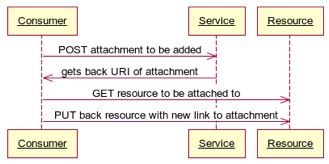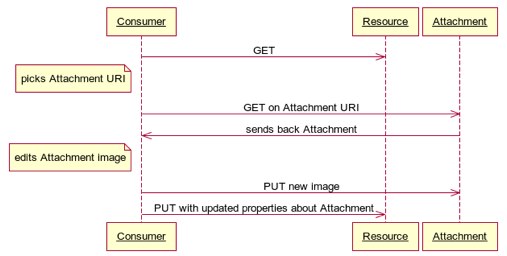This wiki is locked. Future workgroup activity and specification development must take place at our new wiki. For more information, see this blog post about the new governance model and this post about changes to the website.
ROUGH WORKING DRAFT - This page is being used to explore alternatives that may or may not result in common or core specification. As of Feb 2011 it was decided that it would be left to domain workgroups to determine their attachment needs with core guidance on approaches.
 WebSequence Diagrams notation for this interaction:
WebSequence Diagrams notation for this interaction:
 WebSequence Diagrams notation for this interaction:
WebSequence Diagrams notation for this interaction:
What is an Attachment?
Here's our current definition of an attachment:- A resource that is related to another resource and adds supplemental information
- A screen-shot attached to a Change Request
- An office document attached to a Requirement
How should attachments work?
Attachments are Resources. A Resource links to its Attachments.- Attachment should be created via POST
- Attachment should have URI
- Resource should link to its Attachments
Use case #1: Consumer associates Attachment with Resource
The consumer does the work: creating the Attachment if necessary and adding the link to the Resource being attached to. The Consumer may create Resource via POST (as shown below) or Consumer may use an existing Resource as the Attachment, if the Provider allows that. Provider may require that all Attachments be created via Provider's Creation Factory, thus disallowing use of existing Resources. There should be nothing new here. This is how you'd expect things to work with HTTP and RDF. WebSequence Diagrams notation for this interaction:
WebSequence Diagrams notation for this interaction:
Consumer->Service: POST attachment to be added Service->Consumer: gets back URI of attachment Consumer->Resource: GET resource to be attached to Consumer->Resource: PUT back resource with new link to attachment
Use case #2: Consumer displays Resource and list of Attachments
Consumer can display Resource and list of attachments because, in addition to links to Attachments, Resources may contain:- Property values which are links to Attachments
- Property values about the Attachments
- Property values about the Attachments links
Use case #3: Consumer gets and updates an Attachment
In this use case, the Consumer gets a Resource, picks the Attachment to update, gets the Attachment and then puts back the updated Attachment. For example, here a Consumer gets and updates an image Attachment. WebSequence Diagrams notation for this interaction:
WebSequence Diagrams notation for this interaction:
Consumer->Resource: GET note left of Consumer: picks Attachment URI Consumer->Attachment: GET on Attachment URI Attachment->Consumer: sends back Attachment note left of Consumer: edits Attachment image Consumer->Attachment: PUT new image Consumer->Resource: PUT with updated properties about Attachment
| I | Attachment | Action | Size | Date | Who | Comment |
|---|---|---|---|---|---|---|
| |
OslcCoreAttachments__Main__TWiki-1.jpg | manage | 19.6 K | 03 Feb 2011 - 12:56 | DaveJohnson | |
| |
OslcCoreAttachments__Main__TWiki.jpg | manage | 26.8 K | 03 Feb 2011 - 12:56 | DaveJohnson |
Topic revision: r5 - 06 Jul 2011 - 02:12:11 - SteveSpeicher
Contributions are governed by our Terms of Use
Ideas, requests, problems regarding this site? Send feedback

